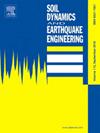考虑不同地震情景的自定心剪力墙耗能需求估算
IF 4.2
2区 工程技术
Q1 ENGINEERING, GEOLOGICAL
引用次数: 0
摘要
在地震过程中,非线性变形历史和结构损伤对结构耗能的影响很大,使结构体系耗能的估算变得复杂。提出了一种基于损伤劣化指标的自定心剪力墙在地震荷载作用下耗能的实用估算方法。该方法依赖于使用有效变形指数对非线性变形历史进行归一化,从而能够将复杂的变形记录转换为具有稳定可变振幅模式的历史。引入阈值参数对相似的变形半周期进行识别和分组,简化了变形历史,同时又不失关键的非线性特征。采用基于频率含量和有效持续时间的分类标准来选择地震动记录,并将其分为四类。然后采用它们来研究所提出的方法在不同地震情景下的适用性。同时,进行参数分析,评估阈值参数、地震烈度、地震特征、关键结构参数(箍筋配筋率、自定心参数、混凝土强度)对所提方法精度和可靠性的影响。结果表明,较小的阈值参数可以保留更多的非线性变形细节,并显著提高能量响应的估计精度,特别是在高烈度和长持续时间地震下。因此,对于归一化过程,建议阈值参数等于0.1。此外,随着结构特征的增加,估计精度得到了提高,突出了该方法在一系列结构配置中的鲁棒性。在不同地震情景下,通过对SCSW进行振动台试验,进一步验证了该方法的准确性和适用性。该方法将能量耗散与基于损伤的劣化指标联系起来,为基于性能的结构抗震设计奠定了基础,有助于实现有针对性的损伤控制,提高低损伤抗震性能。本文章由计算机程序翻译,如有差异,请以英文原文为准。
Estimating the energy dissipation demand of self-centering shear walls considering diverse seismic scenarios
Energy dissipation is significantly influenced by the nonlinear deformation history and structural damage experienced during earthquakes, complicating the estimation of dissipated energy in structural systems. This study proposes a practical estimation method for the energy dissipation of self-centering shear walls (SCSW) under seismic loadings, based on a damage-based deterioration index. The methodology relies on normalizing nonlinear deformation histories using the effective deformation index, which enables the transformation of complex deformation records into histories exhibiting stable variable amplitude patterns. A threshold parameter is introduced to identify and group similar deformation half-cycles, facilitating the simplification of deformation histories without losing critical nonlinear features. Classification criteria based on frequency content and effective duration are employed to select ground motion records and to group them into four different categories. They are then adopted to investigate the applicability of the proposed method under diverse seismic scenarios. Meanwhile, parametric analyses are conducted to assess the influences of the threshold parameter, seismic intensity, earthquake characteristics, and key structural parameters (stirrup reinforcement ratios, self-centering parameters, and concrete strength) on the accuracy and reliability of the proposed method. The results show that smaller threshold parameter values can retain more nonlinear deformation details and yield significantly improved estimation accuracy of the energy responses, particularly under high-intensity and long-duration earthquakes. Consequently, the threshold parameter equaling to 0.1 is recommended for the normalization process. Additionally, improved estimation accuracy is observed with increasing structural features, highlighting the method's robustness across a range of structural configurations. Validation using a shake-table test of an SCSW under different seismic scenarios further confirms the method's accuracy and applicability. By linking energy dissipation to a damage-based deterioration index, the proposed method offers a foundation for performance-based seismic design of SCSWs, facilitating targeted damage control and enhanced low-damage seismic performance.
求助全文
通过发布文献求助,成功后即可免费获取论文全文。
去求助
来源期刊

Soil Dynamics and Earthquake Engineering
工程技术-地球科学综合
CiteScore
7.50
自引率
15.00%
发文量
446
审稿时长
8 months
期刊介绍:
The journal aims to encourage and enhance the role of mechanics and other disciplines as they relate to earthquake engineering by providing opportunities for the publication of the work of applied mathematicians, engineers and other applied scientists involved in solving problems closely related to the field of earthquake engineering and geotechnical earthquake engineering.
Emphasis is placed on new concepts and techniques, but case histories will also be published if they enhance the presentation and understanding of new technical concepts.
 求助内容:
求助内容: 应助结果提醒方式:
应助结果提醒方式:


